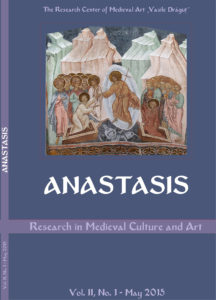Les registres des prophètes et des apôtres dans le tambour de la tour de
l’église St. George de Suceava. Implications liturgiques et historiques
The Registers of the Prophets and Apostles on the Drum of the Tower of St. George Church from Suceava. Liturgical and Historical Implications
Author(s): Emil DragnevSubject(s): Architecture, Visual Arts, Middle Ages, Eastern Orthodoxy
Published by: Editura ARTES
Keywords: medieval mural painting; Moldova in the 15th-16th centuries; Byzantine art; Post-Byzantine art; images of the prophets; prophetical texts; Naboth; Liturgical hymnography
Summary/Abstract: The paintings of “St. George” Metropolitan Church from Suceava, painted both indoors and outdoors in 1534, have been studied only partially so far. By the present study, we aim to provide an iconographic consideration of the paintings within the vaulting system of the nave. Special attention has been paid to the representations of prophets and apostles, inside the tambour of the spire, which display several important peculiarities. In the upper part, there are represented twelve minor prophets and three great prophets, also accompanied by the Prophets Elijah and David. What is astonishing is the fact that the fourth great prophet, Jeremiah, is missing; instead of him, even more surprisingly, Naboth the Israelite is represented – the single image of this character within the class of prophets during the Byzantine and Post-Byzantine epoch. In the case of this unexpected insertion, we have attempted to draw several interpretation tracks, connected with the historical realities of the time. The lower part also contains an uncommon mixture, including eight figures of apostles and prophets each, as well as a little habitual practice of endowing the apostles with texts written on rotuli. The study refers to the repertory of the inscriptions from the rotuli of the prophets and apostles, which are analysed from the perspective of the practices in this field from the Byzantine and Post-Byzantine art, as well as in the context of their liturgical implications. Moreover, the author presented the inscriptions on the rotuli of prophets from the Dodecaorton (The Great Feasts) from the soffit of the oblique arches, also trying to establish a relationship between the prophetical areas of “St. George” Church from Suceava and their evolutions in the Moldavian art from the 15th-16th centuries.
Journal: Anastasis Research in Medieval Culture and Art
- Issue Year: II/2015
- Issue No: 1
- Page Range: 51-98
- Page Count: 48
- Language: French

